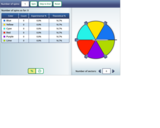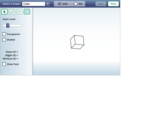
An interactive game for learning theoretical vs experimental probability.
- Subject:
- Mathematics
- Material Type:
- Interactive
- Provider:
- National Council of Teachers of Mathematics
- Provider Set:
- Illuminations
- Date Added:
- 04/12/2021

An interactive game for learning theoretical vs experimental probability.

This resource is about factoring linear and quadratic expressions in one variable, evaluating them at a given value of the variable, multiplying factors to find the expanded form of the expression, and solving linear and quadratic equations.

Use this interactive tool to learn how to find the area of a rectangle. Click on "Instructions" for details on how to use this tool. Click on "Explore" for more ideas.

An interactive game involving coins to learn basic money skills such as counting money, making change and identifying coins of different denominations

"The volume of a cube can be developed by considering unit cubes, a single row (longs) of unit cubes or a single layer (flats) of cubes using this applet." This easy software makes it possible to easily construct a cube and take it apart. [Requires Java.]

This resource investigates the concept of factors by creating rectangular arrays. The interactive tool allows learners to relate area to multiplication.

Students use their knowledge equivalent fractions and their ability to compare fractions to play this computer based game.

An interactive game to learn fractions less than one, greater than or equal to 1, which are written as mixed numbers and their equivalent decimal and percentage forms

Numerator values can be set for 0-20. Denominator values restricted to 1, 2, 4, 5, 8, 10 and 20. Use this interactive tool to show a fraction. Adjust both the denominator and numerator and see a visual representation as a part of a circle, rectangle or a set. Also, you can see the equivalent decimal and percent for each fraction.

The instructional tool explores various geometric solids and their properties. Student can manipulate and color the different shapes. Learners examine the edges, faces, and vertices of the different solid figures.

An interactive game to find number of edges, surfaces and vertices of different geometric shapes.

A game that reviews grouping in fives and tens, and adding and subtracting. The instuctions are clear and include a video of how to play.

An interactive program where students will explore regression lines. Students will be introduced to the correlation coefficient and come to understand what it represents through the given exploration. Requires Java.

Use this applet to learn about a line of best fit for a set of data points. Some example data in this site include statistics from the 2004-2005 LA Lakers season. Students can guess the equation for a set of data points before the applet calculates the equation for the best fitting line.

It is an interactive game to learn counting and graph a number on the number line

Use this tool to strengthen understanding and computation of numerical expressions and equality using a balance scale.

Students use this computer applet to visualize the Pythagorean Theorem.

Try this hands-on approach to solving algebra problems with this interactive website. Students are able to "solve equations, substitute in variable expressions, expand, and factor".

The interactive applet allows learners to explore the relationships between side length, area, and perimeter. Students see how changes in the scale factor influence the ratio of areas and perimeters. [Requires Java.]

This tool allows you to create any geometric shape imaginable. Squares, triangles, rhombi, trapezoids and hexagons can be created, colored, enlarged, shrunk, rotated, reflected, sliced, and glued together.